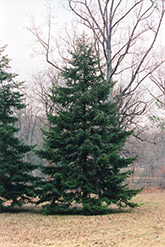Height: 60 feet
Spread: 25 feet
Sunlight:
![]()
Hardiness Zone: 4
Description:
A beautiful specimen, this fir is valued for attractive bluish green needles with showy bluish-white undersides. Some pollution tolerance compared to other firs. Requires moist, well drained soil
Ornamental Features
Veitch Fir is primarily valued in the landscape for its distinctively pyramidal habit of growth. It has attractive dark green foliage with silvery blue undersides. The small needles are highly ornamental and remain dark green throughout the winter.
Landscape Attributes
Veitch Fir is a dense evergreen tree with a strong central leader and a distinctive and refined pyramidal form. Its average texture blends into the landscape, but can be balanced by one or two finer or coarser trees or shrubs for an effective composition.
This is a relatively low maintenance tree, and should not require much pruning, except when necessary, such as to remove dieback. It has no significant negative characteristics.
Veitch Fir is recommended for the following landscape applications;
- Vertical Accent
Planting & Growing
Veitch Fir will grow to be about 60 feet tall at maturity, with a spread of 25 feet. It has a low canopy, and should not be planted underneath power lines. It grows at a medium rate, and under ideal conditions can be expected to live to a ripe old age of 100 years or more; think of this as a heritage tree for future generations!
This tree should only be grown in full sunlight. It requires an evenly moist well-drained soil for optimal growth, but will die in standing water. It is particular about its soil conditions, with a strong preference for sandy, acidic soils. It is quite intolerant of urban pollution, therefore inner city or urban streetside plantings are best avoided. Consider applying a thick mulch around the root zone in both summer and winter to conserve soil moisture and protect it in exposed locations or colder microclimates. This species is not originally from North America.
